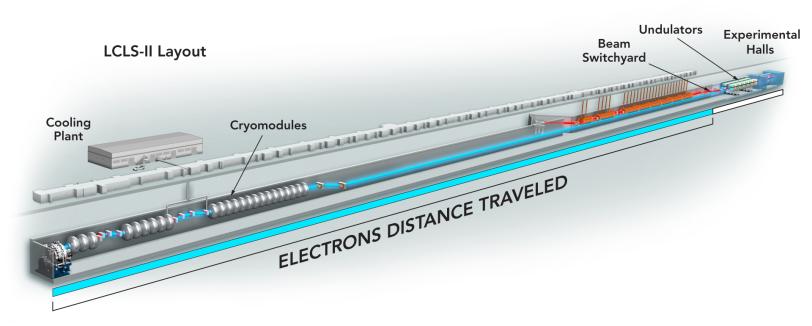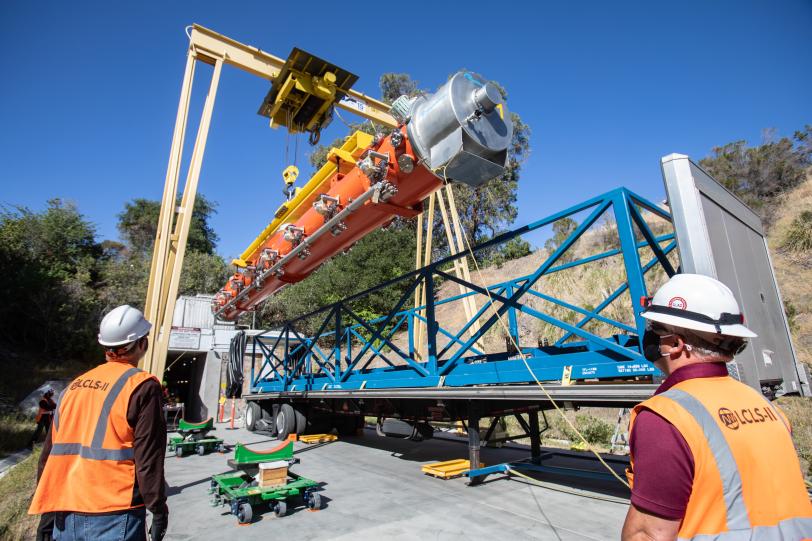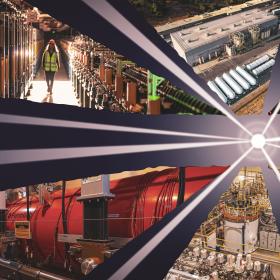Electrons now moving through the superconducting accelerator that will power SLAC’s X-ray laser
The facility is now steps away from releasing an unprecedented stream of ultra-bright X-rays.
By David Krause
After more than a decade of work, electrons are now flying through a new superconducting accelerator at the Department of Energy’s SLAC National Accelerator Laboratory, preparing to power the world’s most powerful X-ray free electron laser. This project – named the Linac Coherent Light Source II (LCLS-II) – is now steps away from releasing X-ray flashes that will open a new era in scientific research at that atomic level.
“Seeing electrons make it all the way through the LCLS-II is proof that our idea to make the source for an extremely powerful superconducting X-ray machine at SLAC is going to work,” Dan Gonnella, lead scientist at SLAC and a group leader in the accelerator directorate, said. “We were confident in our work, but until you see the first electrons actually make it through, you are feeling the butterflies.”
To send electrons through the facility, crews from four national laboratories – Argonne, Berkeley Lab, Fermilab, and Jefferson Lab – and Cornell University, worked together for close to 10 years to build all of the facility’s next-generation components. In 2019, teams installed a state-of-the-art electron gun, while last year, crews turned on a helium cooling plant that brings the temperature of the facility down to two kelvins – colder than outer space.
LCLS-II will produce X-rays that are 10,000 times brighter than those of SLACs existing free-electron laser facility, LCLS – a historic upgrade that will open previously unimaginable views into some of the most pressing scientific questions of our time. The facility will release one million X-ray flashes per second, far more than LCLS’s current rate of 120 flashes per second. The brighter, more rapid bursts of X-rays will allow scientists to tackle challenges such as understanding how to adapt natural solutions for harvesting solar energy for a new generation of clean fuels, inventing sustainable manufacturing methods for industry, and designing a new generation of drugs based on the ability to create molecular movies of how our bodies respond to disease.

“We are not answering only a few questions with the new superconducting accelerator, we are letting scientists answer an incredible number of questions,” SLAC electronics engineering manager Andy Benwell said.
Niobium helps electrons fly
LCLS-II’s extremely cold operating temperature allows the facility to run highly efficiently and conduct electricity with nearly zero resistance. But building an accelerator that has close to zero resistance requires specific materials, including niobium, which is a rare earth metal that is used in other types of machines, like wind turbines and jet engines.
For LCLS-II, a string of bright, hourglass-shaped niobium cavities accelerate electrons inside the facility’s 37 cryomodules. Each cryomodule has eight niobium cavities, meaning LCLS-II has almost 300 cavities – enough to stretch the length of about three soccer fields. The niobium cavities accelerate the electrons until they are flying almost light-speed toward the undulator hall, where they will pass through an exquisitely tuned series of magnets which forces them to travel a zigzag path and give off energy in the form of X-rays. These X-rays are then delivered to a suite of specialized instruments so researchers can conduct experiments.

The cavities enable LCLS-II to deliver an unprecedented stream of pulses that will allow researchers to take detailed movies of atomic-sized processes in nature. These movies will have much higher resolution than the pictures taken at LCLS – up to 8,000 times the number of frames per second than those from the existing accelerator.
“Tracking the motion of atoms and molecules in real time movies will open a new frontier for X-ray science and be groundbreaking for experiments happening around the world,” Gonnella said.
Avoiding dust for a decade
Nothing harms accelerator performance quite like dust. Even the tiniest amounts of dust can destroy the performance of the superconducting cavities. Additionally, if dust finds its way into the accelerator’s injector, the path of the electrons becomes less controllable, producing a “dark current” that can lead to random, unwanted X-rays. Too much dark current inside of an accelerator can ruin its undulator magnets.
“There were certainly opportunities for dust particles to sneak into our new superconducting accelerator,” said John Schmerge, director of SLAC’s Accelerator Directorate. “Crews built the niobium cavities at facilities that are 1,800 or 3,000 miles away from SLAC years before we installed them here. The cavities might have been clean and working well back then, but then you have to wrap them up and ship them across the country on trucks. We then had to install the cryomodules into our tunnel during the fire season in California and weld them together – all of which can introduce dust.”
Why electrons?
SLAC’s superconducting particle accelerator will use electrons to make X-rays. But why electrons? Why not another particle, like protons?
The answer, it turns out, is pretty simple. First, electrons are lighter than other common accelerator particles, like protons. Because they are lighter, they are easier to accelerate to nearly the speed of light, making the facility more efficient and helping researchers generate the kind of rapid, bright X-rays needed for their experiments at SLAC.
Second, electrons are easier to make than some other types of particles. To start LCLS-II’s electron laser beam, an electron gun has to knock electrons free from atoms, hence the name X-ray free-electron laser, or XFEL. Since electrons are lighter and easier to knock out of atoms than other particles, scientists choose them as their go-to particle for X-ray laser experiments.
Avoiding a certain amount of dust is pretty much impossible, Schmerge said. Dust exists in most work environments: Anytime you rub two surfaces together, you make hundreds of thousands of particles. So all of the assembly work had to be done very, very slowly in a well-controlled environment.
Fortunately, the people who worked tirelessly over the years on the superconducting accelerator did a phenomenal job, Schmerge said. They made every effort to produce a clean, world-class superconducting machine, he said. The new facility proves this: Its performance has been as good as when the cavities were first manufactured in partner labs. This has allowed SLAC to achieve the milestone of accelerating the electrons to an energy of 3.5 billion electron volts – or over 99.9999992% the speed of light.
The path to first light
Electrons are now flying through the accelerator, so is LCLS-II ready for experiments? Not quite.
In the month ahead, the team will focus on improving the quality of the electron beam, ready to be directed into the magnetic undulators to produce X-rays. Without a high-quality beam, you might not be able to achieve the experiments you thought you could, Schmerge said. It would be like trying to use a flashlight in the woods at night. When you first turn on the flashlight, you might only see ten or twenty feet in front of you. However, if you start to focus the flashlight’s beam by adjusting its lens, you can see deeper into the woods as the light travels farther before it spreads and dissipates.
“If you have a nice tight electron beam you get better X-ray production,” Schmerge said. “Whereas if the electron beam is all spread out, you don't get very many photons at the end of the tunnel.”
Although there is still a lot of work to be done before X-rays are generated, the team feels a significant sense of accomplishment, SLAC scientist Axel Brachman added.
“Producing a high-energy electron beam gives us a sense that everything is working as we had hoped for,” Brachman said. “The powerful beam is a glimpse of light at the end of our project’s long tunnel.”
About SLAC
SLAC National Accelerator Laboratory explores how the universe works at the biggest, smallest and fastest scales and invents powerful tools used by researchers around the globe. As world leaders in ultrafast science and bold explorers of the physics of the universe, we forge new ground in understanding our origins and building a healthier and more sustainable future. Our discovery and innovation help develop new materials and chemical processes and open unprecedented views of the cosmos and life’s most delicate machinery. Building on more than 60 years of visionary research, we help shape the future by advancing areas such as quantum technology, scientific computing and the development of next-generation accelerators.
SLAC is operated by Stanford University for the U.S. Department of Energy’s Office of Science. The Office of Science is the single largest supporter of basic research in the physical sciences in the United States and is working to address some of the most pressing challenges of our time.







